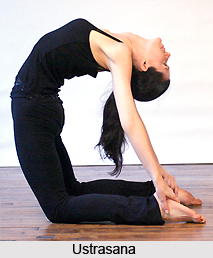 Ustrasana or the camel pose is a significant cultural yoga asana that tones the spinal column. It was first mentioned in the Gheranda Samhita, an 18th century Hatha Yogic text.
Ustrasana or the camel pose is a significant cultural yoga asana that tones the spinal column. It was first mentioned in the Gheranda Samhita, an 18th century Hatha Yogic text.
Meaning of Ustrasana
Ustrasana translates to the camel pose in Sanskrit. The finished posture resembles the humped back of a camel, hence the name. The asana also resembles the Dhanurasana to some extent.
Yoga Texts and Ustrasana
The camel pose was first described in the Gheranda Samhita (1800 CE), indicating that it was known and practiced as an asana at least a few centuries prior to the Samhita`s compilation. Another text that maneions the asana is the Shri Tattva Nidhi, an iconographic Hindu treatise compiled in the 19th century in Mysore, Karnataka.
Practice of Ustrasana
* Assume a sitting posture as in kneeling.
* Support the body on the toes and the knees and gradually lean backward, after having fixed the arms from behind, the palms to the ground, the fingers pointing outward and the thumbs towards the toes.
* Keeping the arms straight, slowly lift the pelvis while taking in the breath.
* Next, press the body above the waist slowly both outward and upward, throwing the neck downward.
* In this posture, the inverted pressure upon the vertebrae should begin to be felt from the small of the back traveling upwards towards the shoulders and the neck, the relative stretching of the thighs, the abdomen, the thorax, the neck and the facial muscles has to follow simultaneously and in appropriate proportion.
* When the pose of Ustrasana is repeated, as a dynamic exercise, it should be maintained during the inspiratory standstill for around 4 seconds. It should be repeated twice only. Those whose health is not active should not follow this posture.
Effects of Ustrasana
Besides the hygienic advantages derived from the preceding snake-pose, Ustrasana accelerates the splanchnic circulation, aids proper drainage through deep pressure, exercises the spine, trunk and the neck. Its influence on the ovaries, thyroid and other endocrine glands is also very favourable. It prevents flabbiness and relieves vertebral pressure upon the spinal cord caused either by- an improper posture-habit or faulty carriage. The forward position or flexion is chosen in Yoga for forcible correction of the distorted spine. Quadriceps, anterior abdominal wall muscles, sternomastoid and wrist extensors are exercised in Ustrasana. There is isometric contraction of the muscles of the upper limb. Upper limb transmits the body weight. Ustrasana improves range of extension of vertebral column. It also improves the range of movement of the hip joint.
Precautions in the practice of Ustrasana
The practise of Ustrasana should be limited to a very short duration and the same should not be repeated. The extension of the spine locks the vertebrae; both dorsal and lumbar, and limits the rotation, especially of the lumbar vertebrae. The vertebrae are not freely movable. It is the forward and side bending position that unlocks the articulations and permits wide-ranging rotation. It is least movable in case of hyper-extenison.



